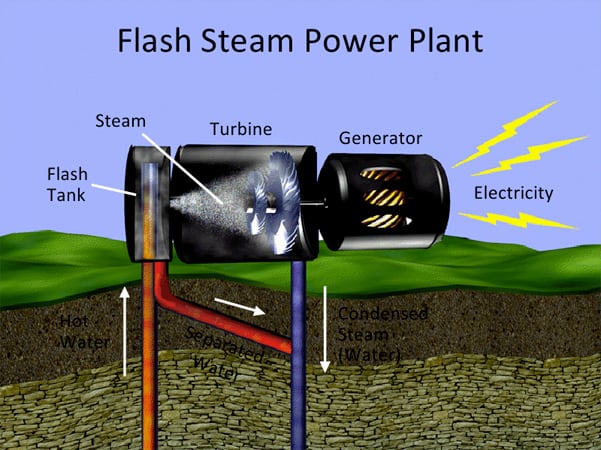Benefits of Geothermal Energy
Geothermal has many advantages over other traditional power sources and other renewable energy sources. These advantages include economic, environmental and supply benefits. Some of the specific advantages:

Baseload Power
Unlike other renewable energy sources, geothermal provides constant baseload power. Geothermal can be produced 365 days of the year.

Environmental Benefits
Geothermal power plants produce almost zero emissions and the surface footprints of plants are small.

Economic Benefits
Geothermal power can be one of the lowest levelized cost of electricity when compared to other renewable energy sources for baseload power.
Hot Sedimentary Geothermal Power 101
Geothermal Power Production
Accessing the Earth’s internal heat requires a medium to carry that energy to the surface where it can be harvested and used in geothermal power plants. The most abundant and common medium used to bring geothermal heat up to surface is groundwater or, when at a sufficiently high temperatures, steam. Groundwater is very common in the geology of the Earth and it occurs almost everywhere below the surface. Geological faults and fractures occur within the structure of the Earth which create conduits for water the move within the ground. This groundwater will accumulate in reservoirs below surface within the pore spaces between rocks.
As we know, the Earth continues to get hotter with depth, and by accessing this groundwater at sufficient depths we find high temperature geothermal resources. Alternatively, areas of higher heat flow within the ground (such as in areas of tectonic or volcanic activity) allow us to access high temperature reservoirs at shallower depths. By drilling water wells into these reservoirs we can pump water to surface to be used in our geothermal power plants.
Geothermal power plants are systems which harvest the earth heat within these natural geo-fluids. Once harvested, that heat energy is converted into electricity through geothermal turbine technology.
The most common systems are:
- Binary Cycle
- Flash Steam
- Dry Steam
Turbine Systems

Binary Cycle Turbines
Binary cycle power generation is the most common method used for converting the heat from lower temperature geothermal resources to electricity. As the name states, a binary cycle power generator is powered by using two separate fluids within the system. The first fluid is the medium for the heat to be transported to surface, most often a brine from a deep saline aquifer. The brine is pumped to the surface from the production wells and goes through a heat exchanger. The heat exchanger transfers all of the heat from the brine over to the second fluid, “the working fluid” that flows within a closed loop to the generator. The key to the second fluid within the system “the working fluid”, is that it flashes at a much lower temperature than the primary fluid from the wells. Most often this working fluid is either a butane or a pentane.
Both the brine and the working fluid are part of two separate and independent closed loops. After the brine goes through the heat exchanger it is piped back to injection wells that pump the cooled brine back into the deep saline aquifer so that it can be re-heated for the closed cycle loop to continue. Once the working fluid is converted to a vapor in the expander, it is piped to cooling towers to be condensed back into a fluid so that the process can be continue for decades to come.


Flash Steam Turbines
A third scenario exists where a geothermal resource exists A flash steam power turbine.at a temperature where both water and steam are produced up the production well. In these flash steam turbines the liquid portion of the water is separated and reinjected to the reservoir and the steam portion is used in the power producing turbine before it is reinjected.

Dry Steam Turbine
Dry steam turbines are used in applications where the A dry steam turbine.geothermal resource is a very high temperature and exists only as steam. Unlike the binary cycle, dry steam applications do not require a heat exchanger or a working fluid and the hot steam is sent directly through the power producing turbine.

Additional Geothermal Heat Potential
Hot water produced from geothermal reservoirs can also be used in applications other than direct power production. Some of these applications include:
- Space heating, district heating and cooling processes;
- Hot springs and spas;
- Aquaculture
- Greenhouses; and
Industrial processes such as:
- Mining industry;
- Augmentation of existing power generation plants;
- Seed and grain drying.



